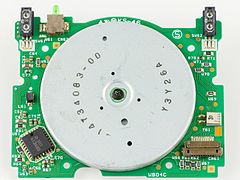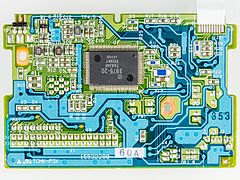Floppy disk drive
A floppy disk drive (or FDD for short “floppy disk drive”) was used to store data. There were internal ones that were integrated into a computer housing; Today's drives are external and usually connected to the computer via USB . The associated data carrier is called a floppy disk (also known as "floppy disk"). This is a magnetic data storage medium in the form of a metal-coated, flexible plastic disc that is placed in a protective cover.
history
With the development of home computers such as the C64 and personal computers , or PCs for short, the floppy disk began its triumphant advance as a storage medium. With the huge amounts of data that arise today (especially with image and video data, and the ever-increasing programs), the comparatively low storage capacity of max. 2.88 MB, however, is one reason that diskettes have hardly been used for data storage since 2003. Data was gradually saved on CD-ROM , tape drives , zip drives , today on USB mass storage devices , external hard drives or even decentralized in the cloud . The floppy disk drives still in use today are usually no longer built-in devices, but are connected to the computer as an external device via a USB port.
function
The essential mechanical elements of a floppy disk drive are always the same: A mechanism clamps and centers the floppy disk on the axis of rotation and also serves to eject the floppy disk. The mechanism simultaneously raises / lowers the upper and lower write head or, in the case of single-sided drives, the pressure felt instead of the lower read head. The mechanism works mostly manually, only with some devices from Apple and Sun it was motorized. Other components are a speed-controlled motor for evenly rotating the diskette (belt and direct drive are common), and one or two combined read and write heads that can be moved in one direction with an opposing pressure felt on metal rails or, in the case of double-sided drives, a pair of heads and a stepper motor to move the head, whereby the individual tracks are approached. This requires the electronics that operate and regulate the motors, bring the write and read signals to the correct field strength, and amplify and digitize the read signals. Further processing takes place in a floppy disk controller , which is often located outside the actual drive, e.g. B. on the motherboard of a PC.
While 8 ″ drives usually run non-stop after being switched on and the read / write heads lift off the floppy disk to protect them when not in use, the smaller versions only switch the motor on when required; the heads can therefore always remain on the disk surface without the heads and disk surface being excessively worn.
In order to be able to recognize the beginning of a data track, the synchronization , more easily when reading , the floppy disks are provided with an index hole , which is usually near the inner edge. A light barrier is built into the drive , which emits a signal when this hole passes the light barrier during rotation. Most floppy disks only have one such index hole; the division of a single data track into a number of sectors must be done by software in the controller firmware or by the computer CPU, so in this case we speak of "soft-sectored" floppy disks. The opposite are "hard-sectored" floppy disks, which have a separate index hole for each data sector, i.e. a whole wreath of them. The early Apple computers used this otherwise rather uncommon method. The somewhat more exotic format of the Amiga computers completely ignored the index hole and only recognized the beginning of the track in software.
Another synchronization concerns the position of the write head so that it hits the first and all subsequent tracks correctly. In the case of the drives for the 8-bit computers from Commodore , the write head was deliberately pushed against the inner stop five times during initialization or after reading errors were detected, which produced a characteristic rattling noise.
The communication between drive and computer can be realized on different levels. In the early days of microcomputers in particular, there were many variants: while Apple devices used the lowest bit stream level for communication , the early Atari home computers used the higher data block level and 8-bit computers from Commodore on the even higher file level. A standard has emerged for today's devices: Internal floppy disk drives for PCs (with a classic ribbon cable connection) communicate at the bitstream level, all other devices, e.g. B. USB floppy disk drives, at data block level.
- Components of a 3.5-inch floppy disk drive
Stepper motor with threaded spindle for the magnetic head
Designs
The designs correspond to those of the diskettes: 200 mm (8 ″) the original disk format from IBM as a replacement for the previously necessary stacks of punched cards , 130 mm (5¼ "), 90 mm (3½") and 75 mm (3 ") on a cutter CPC that didn't catch on.
Connection (bus)
- (IBM) PC drive, 5.25 "or 3.5"
internal floppy drives are connected to the controller via a 34-pin ribbon cable (data, control). They also have a 4-pin power connection to the power pack.
Extra-flat 3.5 ″ floppies, which were originally developed for installation in a laptop and are now (as of 2016) widely used in USB-connected external devices, are connected with a 26-pin ribbon cable (to the USB adapter chip ), which also contains the power supply. - Shugart bus was at times a de facto standard for floppy drives, developed by Shugart Associates . 8 ″ drives are connected using a 50-pin interface, while 5 1 ⁄ 4- inch, 3 1 ⁄ 2 -inch and 3-inch drives are connected using a 34-pin interface, although the pin assignments are similar.
maintenance
The writing head must be carefully cleaned from time to time, as iron oxide residues and binding material residues are deposited on it. Cleaning disks used to be available, but it is more gentle to open the drive and gently wipe the head (s) with a lint-free cloth soaked in isopropanol until the brownish oxide residue has been removed. Lubricating the mechanics is not recommended, unless it is obviously jammed. If necessary, the rotational speed of the diskette and the track position of the stepper motor can be readjusted for many drives, but this is only recommended if you have the appropriate knowledge, as otherwise the drive can easily be rendered unusable.
literature
- Klaus Dembowski: PC workshop. Configure, optimize and repair hardware, Markt + Technik Verlag, Munich 2008, ISBN 978-3-8272-4371-3 .
- Klaus Dembowski: BIOS and Troubleshooting. Markt + Technik Verlag, Munich 2004, ISBN 3-8272-6547-9 .
- Hans-Peter Messmer, Klaus Dembowski: PC hardware book. Structure, functionality, programming, 7th edition, Addison-Wesley, Munich, ISBN 3-8273-2014-3 .
See also
Web links
- Install floppy disk drive (accessed February 26, 2016)











